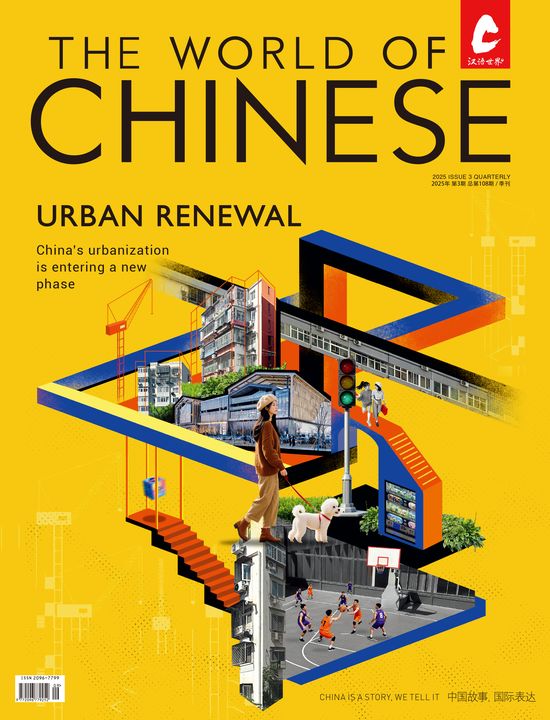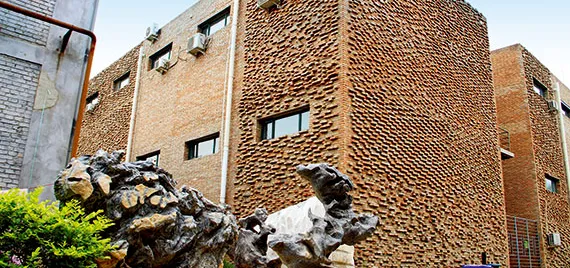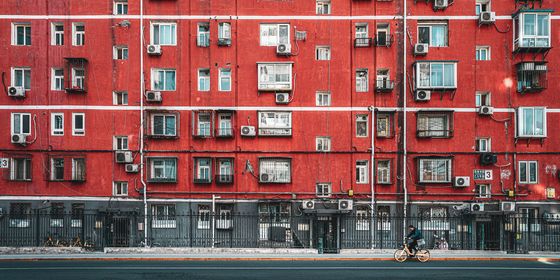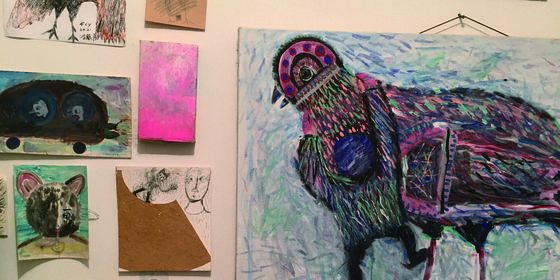Building artist villages away from the hustle and bustle
If the 19th-century European stereotype of the artist is a depressive genius in a drafty garret, the 20th-century American cliché is of artists taking over post-industrial urban lofts, scratching out a living in a high-ceilinged warehouse before they are priced out by gentrifying forces.
China is no different.
The 21st-century Chinese art scene has areas like Beijing’s 798 Art District, whose graffitied façades and rusty pipes can pass at a distance for bohemian Bushwick or Shoreditch, London. However, in the northeast quadrant of Beijing’s Chaoyang District, there is a set of art communities of a “postagricultural” character that is unique to the story of Chinese urban development.
The village of Feijiacun (费家村) is a 10-minute bus ride from the second-last stop on Beijing’s Subway Line 14. A dusty road leads from a traditional paifang-style gate past a line of scrappy groceries and diners; the windowless high-rises, cranes, and other signs of Beijing’s remorseless construction drive are not visible from the middle of the village street, which is instead traversed by stray dogs and bikes loaded with fresh produce, small restaurants, and shops. However, now and then, the road opens onto vine-covered entrances of what seem to be traditional courtyard homes adorned with signs in vivid colors, impeccably spelled English, and sleek typefaces in contrast to the cheap signage of the noodle shop a few steps away.
Feijiacun, though the smallest village by area in Chaoyang District’s Cuigezhuang County, is one of the 10 major art districts of Beijing. Painters, photographers, tattoo artists, and film distribution companies live and work side by side with the former villagers and newly arrived migrant workers attracted to the city’s outskirts by affordable rent. In the middle of the village, a former pickled vegetable factory houses the Shangri-la Cultural and Arts Community, one of the larger art communities in the district. There you can find the airy new rehearsal and training center of the Beijing Dance Theater, an internationally renowned contemporary dance troupe, and a number of smaller tenants ranging from potters and sculptors to the Red Gate Gallery international residency program.
“Most regular people don’t know about us, but artists have been coming here for a long time,” said Tan, the property manager of the Shangrila Community who wished to go by his surname. “Most people have heard of 798, and they’re of course a bigger deal than us, but we actually got started earlier. What the artists here are looking for is a peaceful and affordable environment to work in and above all, a quiet place to live.”
POLITICS OF SPACE
Art districts and villages are seen in many Chinese urban areas, including Shanghai, Chengdu and Xi’an. Beijing’s art villages, however, are undoubtedly among the most wellknown. The most famous village of them all, Caochangdi (草场地), is actually a little closer geographically to 798 and more used to being the center of the action than Tan’s earlier generalization would suggest. Located just a five-minute bus ride northeast of 798 in the Dashanzi Sub-District of Chaoyang District, Caochangdi made waves when Ai Weiwei, arguably China’s most controversial artist, built his house and studio compound, 258 FAKE Studio, in the neighborhood in 1999.
Though considered an odd choice of neighborhood at the time, Ai was soon joined by prestigious domestic and international colleagues like the Peking Fine Arts Gallery and Galerie Urs-Meile from Lucerne. Architects and media alike have been struck by the visual of kooky sculptures, international gallery shows, and China’s finest avant-garde sensibilities being made in close proximity to chickens, sheep, and the marginal and migratory parts of Chinese society.
“It’s under the radar, it’s not pretentious, and there are the large spaces and freedom to move and do without all the eyes of those living with all the norms of society looking on,” Mary-Ann Ray and Robert Mangurian, architects and urban researchers, told TWOC, explaining the appeal that the village holds for artists as well as themselves.
Ray and Mangurian are the principals behind BASE Studio, a Beijing architectural think-tank, and the authors of Caochangdi, Beijing Inside Out, an architectural and sociological study of the contemporary transformation of Caochangdi. They say they discovered neighbourhood almost by accident, when the project space they leased in 798 was reappropriated by the district cultural department and they needed to relocate on the fly. In a book lecture given at the London School of Economics, Ray noted that in this way, BASE also became another “illegal” resident in a village made up of mostly illegal construction and “ad-hoc, mongrel architecture”.
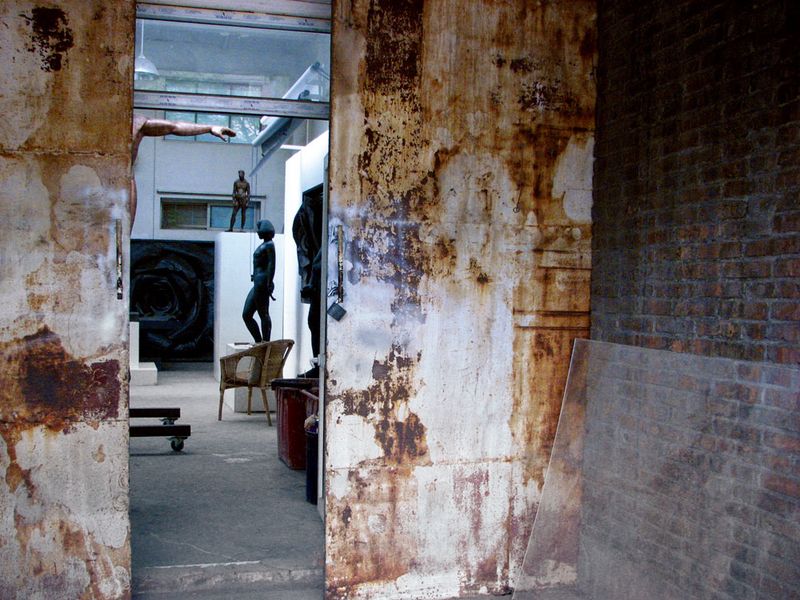
A former pickled vegetable factory now houses one of the many artist workshops in the Shangri-la Community in Feijiacun
The urban village (城中村, village within the city) is a description applied to Caochangdi, Feijiacun and several hundred other locations in Beijing, though they are more prevalent in Southern China. As Chinese cities sprawl outwards, villages located on the outskirts of cities have seen their agricultural land by the government to allow new construction while the villagers themselves were permitted to remain on residential land. The concept of rural collective land-ownership, which has remained after the Maoist period, creates ambiguities for the expropriation of residential village land that lead to higher costs of relocation and compensating and relocating villagers—as well as risk of potential dispute—than is considered worthwhile to many developers.
These days, rural collectives in urban areas in China can transform themselves into collectively owned property companies. Villagers who have lost their agricultural land have a new livelihood in remodelling or adding onto their traditional singlestorey dwellings, which can be rented out to the “floating population” of migrant workers from the countryside, workers driven out of the urban core by rising costs of living, as well as creative professionals and artists.
Caochangdi and Feijiacun were both once imperial burial grounds of the Qing Dynasty, and later agricultural people’s communes. They also saw semi-privatized industrial development in the post-1978 reform era. Architecture that reflects both the agricultural and industrial development eras can be seen in these neighbourhoods. Feijiacun even has a side street full of studios in barracklike brick buildings complete with rusty gates and uniformly numbered door-plates, though these turned out to have been built in the mid-2000s by a developer that the village collective contracted due to rising demand from artists.
Because construction in the urban villages is mostly illegal and unregulated, it results in ultra-dense development poorly served by public utilities. In contrast to the slumlike density associated with villages in Guangzhou and Shenzhen, Caochangdi, and Feijiacun still have courtyards, fields and an average building height of less than three storeys. Nonetheless, even in Beijing the term “urban village” conjures an image of lawlessness and poverty. Tan objected to Feijiacun being considered an urban village, however much the shoe technically fits.
“Urban village is not a good concept—I don’t want that label to be applied here,” he said. “Artists have been settling here for a long time, before a lot of the development, before there was even much migrant housing, and they come here because it’s actually a nicer environment than the city.”
Their image problems aside, villages within the urban sprawl have an undeniable economic appeal. Lofts for rent in Caochangdi are currently advertised online for as low as 0.8 RMB per square meter per day, while most cost two to three RMB per square meter per day. In nearby Huantie Arts District and Feijiacun, the prices are even lower, with most spaces currently advertised at below two RMB per square meter. According to Atron, China’s web portal for artrelated news, until two years ago all long-term tenants in Huantie were paying 0.8-0.9 RMB per square meter. Though artists can spend tens of thousands of RMB renovating their studios before moving in, these prices are a steal in a city where, according to an investigation by the China Office Research Council in 2014, office spaces have rented for an average of 311 RMB per square meter per month.
As Tan noted, there’s also an aesthetic appeal for the artist in an urban village as well. Ai Weiwei’s FAKE Studio responsible for designing the iconic brick-faced lofts in Caochangdi, which, according to Mangurian and Ray, are all illegal. Ai’s austere, factory-style designs were meant to be a hybrid of the New York loft and the traditional Chinese courtyard house. The land was leased from the village leader taken at the studio’s own risk of future expropriation. The precariousness of life in the village echoes the disappearing courtyard homes of Beijing that Ai’s architecture is supposed to evoke.
“Still Life in the City” is a story from our newest issue, “Farming”. To read the whole piece, become a subscriber and receive the full magazine. Alternatively, you can purchase the digital version from the iTunes Store.
